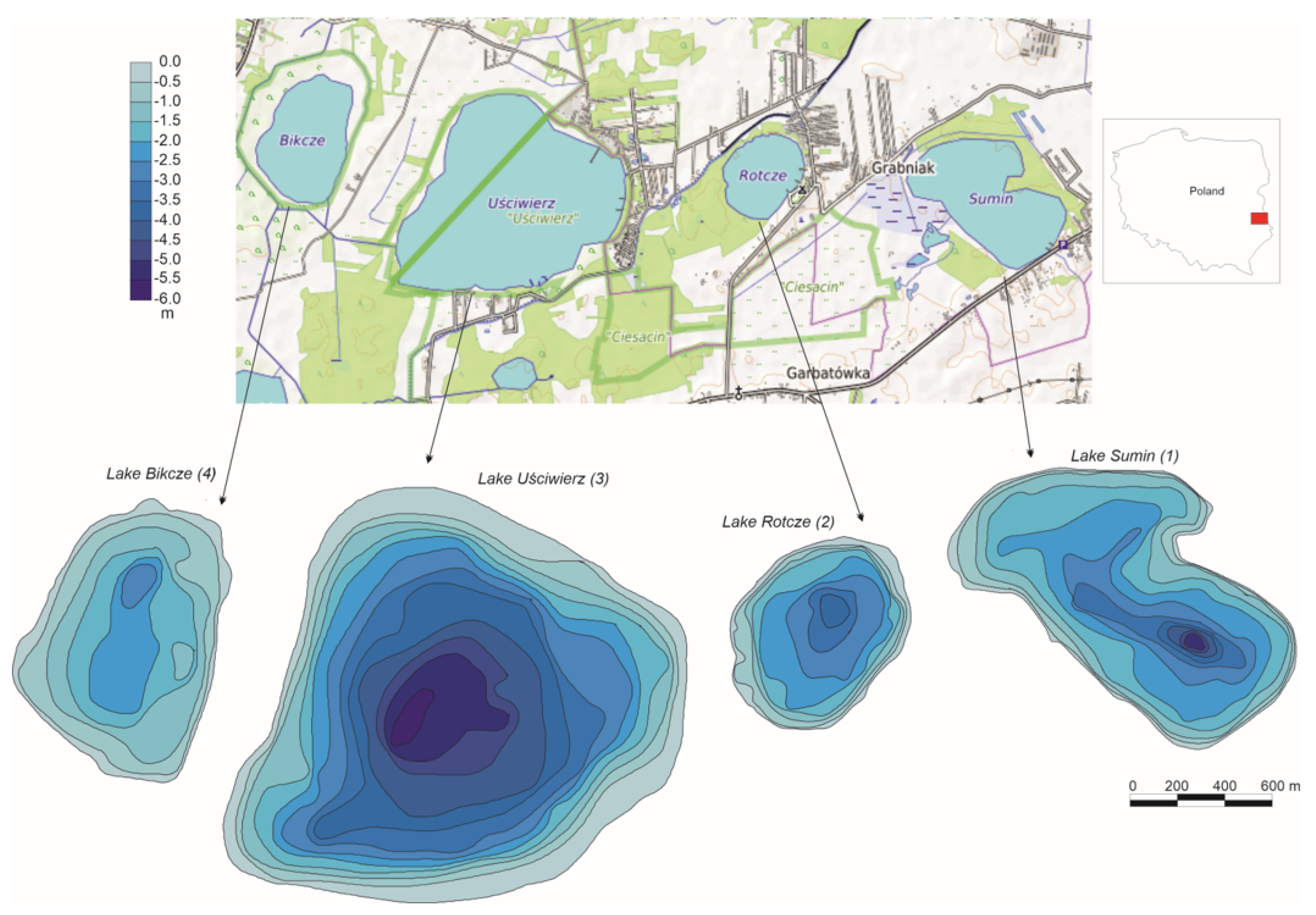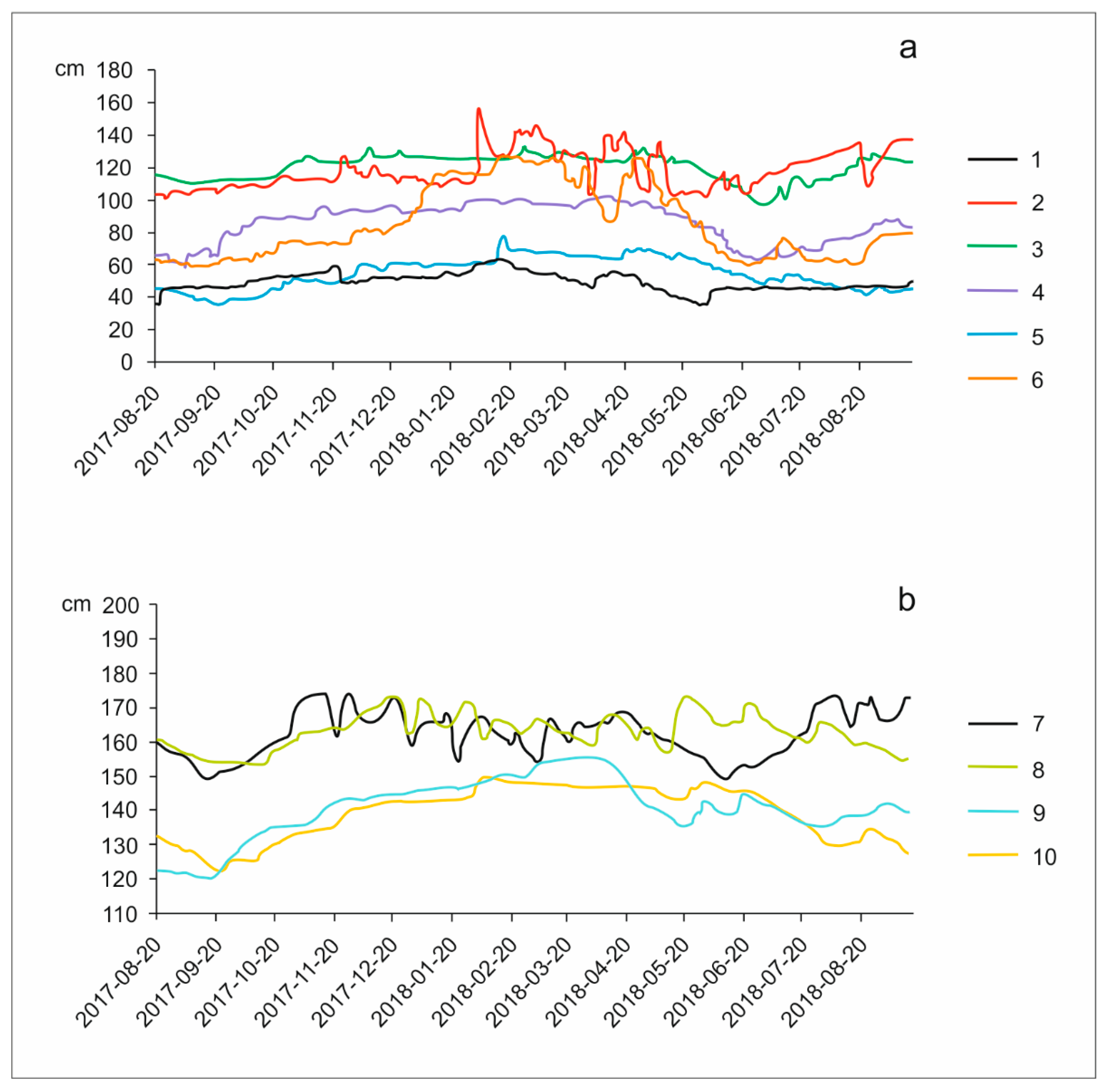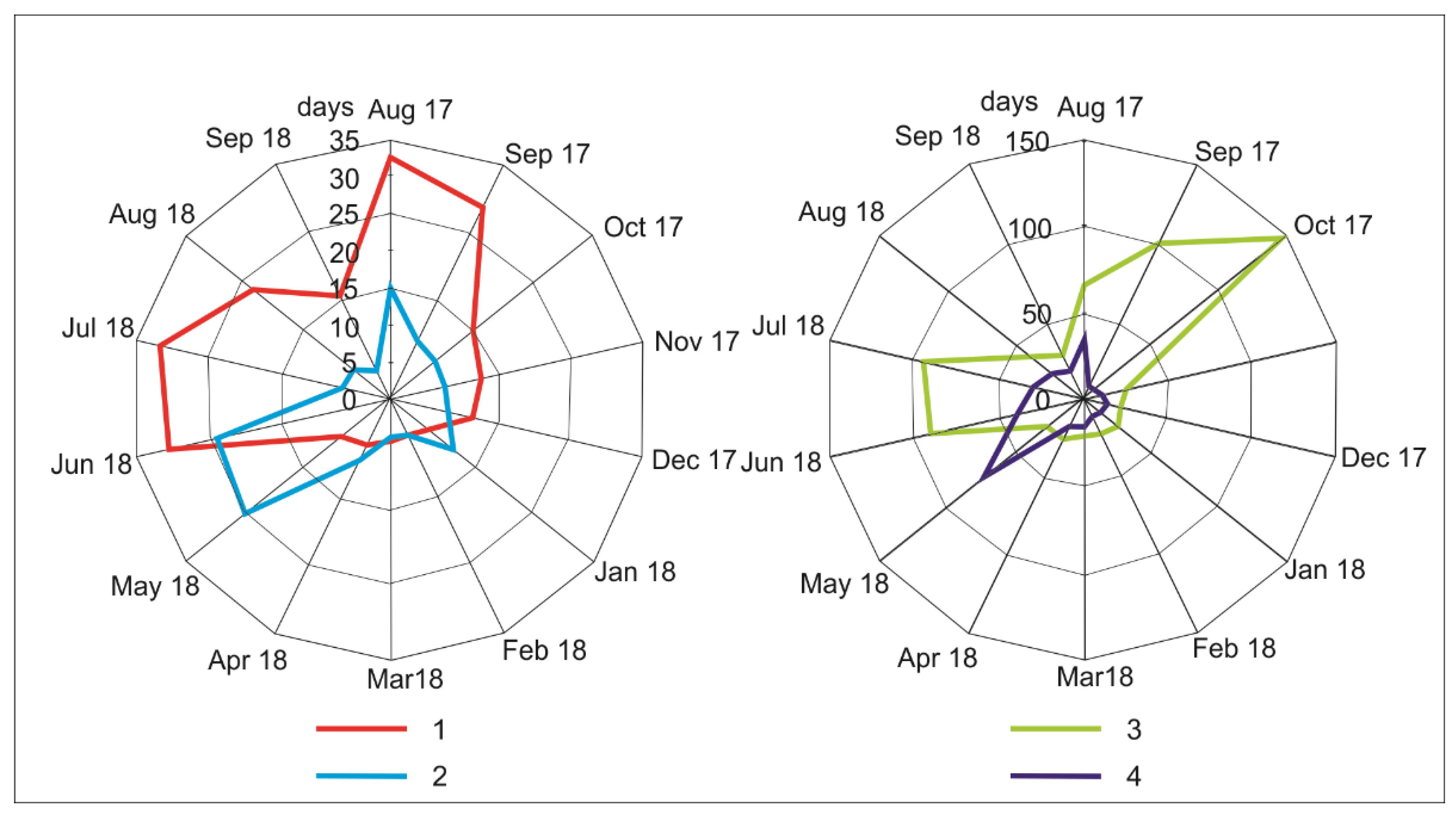Water Renewal Time in Lakes with Transformed Water Distribution in the Catchment Areas
Abstract
1. Introduction
2. Materials and Methods
2.1. Study Site
2.2. Hydrological and Limnological Measurements
2.3. Statistical Analyses
3. Results
4. Discussion
5. Conclusions
Author Contributions
Funding
Data Availability Statement
Conflicts of Interest
References
- Česonienė, L.; Šileikienė, D.; Dapkienė, M. Relationship between the Water Quality Elements of Water Bodies and the Hydrometric Parameters: Case Study in Lithuania. Water 2020, 12, 500. [Google Scholar] [CrossRef]
- Ramon, C.L.; Ulloa, H.N.; Doda, T.; Bouffard, D. Flushing the lake littoral region: The interaction of differential cooling and mild winds. Water Resour. Res. 2022, 58, e2021WR030943. [Google Scholar] [CrossRef]
- Zhao, X.; Liu, X.; Xing, Y.; Wang, L.; Wang, Y. Evaluation of water quality using a Takagi-Sugeno fuzzy neural network and determination of heavy metal pollution index in a typical site upstream of the Yellow River. Environ. Res. 2022, 211, 113058. [Google Scholar] [CrossRef] [PubMed]
- Godoy, R.F.B.; Kuroda, C.Y.; Radomski, F.A.D.; de la Cruz Guerra, B. Eutrophication: A threat to freshwater reservoirs and human health. Multidiscip. Rev. 2019, 2, e2019007. [Google Scholar] [CrossRef]
- Palanques, A.; Guillén, J.; Puig, P.; Grimalt, J.O. Effects of flushing flows on the transport of mercury-polluted particulate matter from the Flix Reservoir to the Ebro Estuary. J. Environ. Manag. 2020, 260, 110028. [Google Scholar] [CrossRef]
- Janssen, A.B.G.; van Wijk, D.; van Gerven, L.P.A.; Bakker, E.S.; Brederveld, R.J.; DeAngelis, D.L.; Janse, J.H.; Mooij, W.M. Success of lake restoration depends on spatial aspects of nutrient loading and hydrology. Sci. Total Environ. 2019, 679, 248–259. [Google Scholar] [CrossRef]
- Björnerås, C.; Persson, P.; Weyhenmeyer, G.A.; Hammarlund, D.; Kritzberg, E.S. The lake as an iron sink—New insights on the role of iron speciation. Chem. Geol. 2021, 584, 120529. [Google Scholar] [CrossRef]
- Morison, M.Q.; Higgins, S.N.; Webster, K.L.; Emilson, E.J.S.; Yao, H.; Casson, N.J. Spring coherence in dissolved organic carbon export dominates total coherence in Boreal Shield forested catchments. Environ. Res. Lett. 2022, 17, 014048. [Google Scholar] [CrossRef]
- EC, Parliament Council. Directive of the European Parliament of the Council. 2000/60/EC; Brussels, Belgium. 2000. Available online: https://eur-lex.europa.eu/eli/dir/2000/60/oj (accessed on 12 November 2023).
- Monsen, N.E.; Cloern, J.E.; Lucas, L.V.; Monismith, S.G. The use of flushing time, residence time, and age as transport time scales. Limnol. Oceanogr. 2002, 47, 1545–1553. [Google Scholar] [CrossRef]
- van Wijk, D.; Teurlincx, S.; Brederveld, R.J.; de Klein, J.J.M.; Janssen, A.B.G.; Kramer, L.; van Gerven, L.P.A.; Kroeze, C.; Mooij, W.M. Smart Nutrient Retention Networks: A novel approach for nutrient conservation through water quality management. Inland. Waters 2021. [Google Scholar] [CrossRef]
- Moyle, M.; Boyle, J.F. A method for reconstructing past lake water phosphorus concentrations using sediment geochemical records. J. Paleolimnol. 2021, 65, 461–478. [Google Scholar] [CrossRef]
- Ury, E.A.; Arrumugam, P.; Herbert, E.R.; Badiou, P.; Page, B.; Basu, N.B. Source or sink? Meta-analysis reveals diverging controls of phosphorus retention and release in restored and constructed wetlands. Environ. Res. Lett. 2023, 18, 083002. [Google Scholar] [CrossRef]
- Pham Van, C.; De Brye, B.; De Brauwere, A.; Hoitink, A.J.F.; Soares-Frazao, S.; Deleersnijder, E. Numerical Simulation of Water Renewal Timescales in the Mahakam Delta, Indonesia. Water 2020, 12, 1017. [Google Scholar] [CrossRef]
- Masse-Dufresne, J.; Barbecot, F.; Baudron, P.; Gibson, J. Quantifying floodwater impacts on a lake water budget via volume-dependent transient stable isotope mass balance. Hydrol. Earth Syst. Sci. 2021, 25, 3731–3757. [Google Scholar] [CrossRef]
- Carleton, J.N.; Lee, S.S. Modeling lake recovery lag times following influent phosphorus loading reduction. Environ. Model. Softw. 2023, 162, 105642. [Google Scholar] [CrossRef] [PubMed]
- Sikder, M.S.; Wang, J.; Allen, G.H.; Sheng, Y.; Yamazaki, D.; Song, C.; Ding, M.; Crétaux, J.F.; Pavelsky, T.M. Lake-TopoCat: A global lake drainage topology and catchment database. Earth Syst. Sci. Data 2023, 15, 3483–3511. [Google Scholar] [CrossRef]
- Londe, L.R.; Novo, E.M.L.M.; Barbosa, C.; Araujo, C.A.S. Water residence time affecting phytoplankton blooms: Study case in Ibitinga Reservoir (São Paulo, Brazil) using Landsat/TM images. Braz. J. Biol. 2017, 76, 664–672. [Google Scholar] [CrossRef]
- Kohzu, A.; Matsuzaki, S.S.; Komuro, S.; Komatsu, K.; Takamura, N.; Nakagawa, M.; Imai, A.; Fukushima, T. Identifying the true drivers of abrupt changes in ecosystem state with a focus on time lags: Extreme precipitation can determine water quality in shallow lakes. Sci. Total Environ. 2023, 881, 163097. [Google Scholar] [CrossRef]
- Adhar, S.; Barus, T.A.; Nababan, E.S.N.; Wahyuningsih, H. Trophic state index and spatio-temporal analysis of trophic parameters of Laut Tawar Lake, Aceh, Indonesia. Aquacult. Aquar. Conserv. Legis. 2023, 16, 342–355. [Google Scholar]
- Vagle, S.; Carmack, E. Annual patterns of stratification, mixing and ventilation in long, deep, seasonally ice-covered François lake, British Columbia, Canada. Front. Earth Sci. 2023, 11, 1090124. [Google Scholar] [CrossRef]
- Pilotti, M.; Simoncelli, S.; Valerio, G. A simple approach to the evaluation of the actual water renewal time of natural stratified lakes. Water Resour. Res. 2014, 50, 2830–2849. [Google Scholar] [CrossRef]
- Boehrer, B.; Schultze, M. Stratification of lakes. Rev. Geophys. 2008, 46, RG2005. [Google Scholar] [CrossRef]
- Salas De Leon, D.A.; Alcocer, J.; Ardiles Gloria, V.; Quiroz-Martinez, B. Estimation of the eddy diffusivity coefficient in a warm monomictic tropical lake. J. Limnol. 2016, 75, 161–168. [Google Scholar] [CrossRef]
- George, D.G.; Hurley, M.A. Using a continuous function for residence time to quantify the impact of climate change on the dynamics of thermally stratified lakes. J. Limnol. 2003, 62, 21–26. [Google Scholar] [CrossRef]
- Alhamarna, M.Z.; Tandyrak, R. Lakes restoration approaches. Limnol. Rev. 2021, 21, 105–118. [Google Scholar] [CrossRef]
- Enawgaw, Y.; Wagaw, S. Phytoplankton communities and environmental variables as indicators of ecosystem productivity in a shallow tropical lake. J. Freshw. Ecol. 2023, 38, 2216244. [Google Scholar] [CrossRef]
- Erratt, K.J.; Creed, I.F.; Trick, C.G. Harmonizing science and management options to reduce risks of cyanobacteria. Harmful Algae 2022, 116, 102264. [Google Scholar] [CrossRef]
- Kowalewski, G. Over 200 years of drainage practices and lake level drawdown in the Uściwierskie Lowering (Łęczna-Włodawa Lakeland). Limnol. Rev. 2012, 12, 179–190. [Google Scholar] [CrossRef]
- Grzywna, A.; Nieścioruk, K. Changes of hydrographic network of uściwierskie lowering according to cartographic materials. J. Ecol. Eng. 2016, 17, 148–153. [Google Scholar] [CrossRef][Green Version]
- Sender, J.; Urban, D.; Różańska-Boczula, M.; Garbowski, M. Factors Influencing Helophyte Distribution in Lakes (Eastern Poland). Water Resour. 2020, 47, 315–324. [Google Scholar] [CrossRef]
- Ferencz, B. The Lake-Catchment Systems of Three Łęczna-Włodawa Lakes with Cretaceous Rocks in Their Catchment Areas; Manuscript of UAM: Poznań, Poland, 2011. [Google Scholar]
- Toporowska, M.; Ferencz, B.; Dawidek, J. Impact of lake-Catchment processes on phytoplankton community structure in temperate shallow lakes. Ecohydrology 2018, 11, e2017. [Google Scholar] [CrossRef]
- Ferencz, B.; Toporowska, M.; Dawidek, J. Temporal and vertical relations between various environmental factors in the largest lake of Łeczna-Włodawa lake district (Eastern Poland). Water 2019, 11, 1263. [Google Scholar] [CrossRef]
- Lenard, T.; Ejankowski, W.; Poniewozik, M. Responses of Phytoplankton Communities in Selected Eutrophic Lakes to Variable Weather Conditions. Water 2019, 11, 1207. [Google Scholar] [CrossRef]
- Dawidek, J.; Pęczuła, W.; Ferencz, B. The role of catchment and in-lake processes in shaping trophic conditions of the shallow lake Syczyńskie (Eastern Poland). Ecoh Hydrob. 2009, 9, 193–200. [Google Scholar] [CrossRef]
- Berggren, M.; Klaus, M.; Selvam, B.P.; Ström, L.; Laudon, H.; Jansson, M.; Karlsson, J. Quality transformation of dissolved organic carbon during water transit through lakes: Contrasting controls by photochemical and biological processes. Biogeosciences 2018, 15, 457–470. [Google Scholar] [CrossRef]
- Adamczuk, M.; Pawlik-Skowrońska, B.; Solis, M. Do anthropogenic hydrological alterations in shallow lakes affect the dynamics of plankton? Ecol. Indic. 2020, 114, 106312. [Google Scholar] [CrossRef]
- Ferencz, B.; Dawidek, J. Water exchange of three shallow Łęczna-Włodawa Lakes. Limnol. Rev. 2012, 12, 65–72. [Google Scholar] [CrossRef]
- Wu, Z.; Zhang, D.; Cai, Y.; Wang, X.; Zhang, L.; Chen, Y. Water quality assessment based on the water quality index method in Lake Poyang: The largest freshwater lake in China. Sci. Rep. 2017, 7, 17999. [Google Scholar] [CrossRef]
- Knapp, A.S.; Milewski, A.M. Spatiotemporal Relationships of Phytoplankton Blooms, Drought, and Rainstorms in Freshwater Reservoirs. Water 2020, 12, 404. [Google Scholar] [CrossRef]
- Lenard, T.; Ejankowski, W. Natural water brownification as a shift in the phytoplankton community in a deep hard water lake. Hydrobiologia 2017, 787, 153–166. [Google Scholar] [CrossRef]
- McDonald, C.P.; Lathrop, R.C. Seasonal shifts in the relative importance of local versus upstream sources of phosphorus to individual lakes in a chain. Aquat. Sci. 2016, 79, 385–394. [Google Scholar] [CrossRef]
- Ferencz, B.; Dawidek, J. The flushing time based on underground supply in the uppermost located Łęczna—Włodawa Lakes. Scott. Geogr. J. 2014, 130, 243–251. [Google Scholar] [CrossRef]
- Kuriata-Potasznik, A.B.; Szymczyk, S. Variability of the water availability in a river lake system—A case study of Lake Symsar. J. Water Land. Dev. 2016, 31, 87–96. [Google Scholar] [CrossRef]
- Li, Y.; Zhang, Q.; Yao, J. Investigation of residence and travel times in a large floodplain lake with complex lake-river interactions: Poyang Lake (China). Water 2015, 7, 1991–2012. [Google Scholar] [CrossRef]
- Andradóttir, H.O.; Rueda, F.J.; Armengol, J.; Marcé, R. Characterization of residence time variability in a managed monomictic reservoir. Water Resour. Res. 2012, 48, W11505. [Google Scholar] [CrossRef]
- Suchożebrska, M.; Chabudziński, Ł. Anthropogenic Transformations of the Hydrographical Network in Lake Catchment Areas of the Uściwierz Lowering (Łęczna Włodawa Lake District). Limnol. Rev. 2007, 7, 225–231. [Google Scholar]
- Sender, J. Impact of the Drainage System on Water Vegetation of the Lowland Lakes (Eastern Poland). Turk. J. Fish. Aquat. Sci. 2018, 18, 611–622. [Google Scholar] [CrossRef] [PubMed]
- Soranno, P.A.; Webster, K.E.; Riera, J.L.; Kratz, T.K.; Baron, J.S.; Bukaveckas, P.A.; Kling, G.W.; White, D.S.; Caine, N.; Lathrop, R.C.; et al. Spatial variation among lakes within landscapes: Ecological organization along lake chains. Ecosystems 1999, 2, 395–410. [Google Scholar] [CrossRef]
- El-Zehairy, A.A.; Lubczynski, M.W.; Gurwin, J. Interactions of artificial lakes with groundwater applying an integrated MODFLOW solution. Hydrogeol. J. 2018, 26, 109–132. [Google Scholar] [CrossRef]




| Lake Sumin | Lake Rotcze | Lake Uściwierz | Lake Bikcze | |
|---|---|---|---|---|
| Area (m2) | 959,796 | 437,476 | 2,385,872 | 710,900 |
| Volume (m3) | 1,612,475 | 766,743 | 5,960,849 | 804,612 |
| Maximum depth (m) | 5.4 | 3.9 | 5.92 | 2.7 |
| Mean depth (m) | 1.68 | 1.75 | 2.49 | 1.13 |
| Length (m) | 1463 | 847 | 2181 | 1206 |
| Width (m) | 1003 | 675 | 1875 | 860 |
| Shoreline (m) | 4355 | 2505 | 6106 | 3347 |
| Aug 17 | Sep 17 | Oct 17 | Nov 17 | Dec 17 | Jan 18 | Feb 18 | Mar 18 | Apr 18 | May 18 | Jun 18 | Jul 18 | Aug 18 | |
|---|---|---|---|---|---|---|---|---|---|---|---|---|---|
| Monthly sums of precipitation | |||||||||||||
| 79.8 | 54.5 | 95.8 | 61.2 | 31.5 | 17.0 | 16.9 | 5.5 | 57 | 16.3 | 48.1 | 6.7 | 121.6 | |
| Average discharge | |||||||||||||
| 1. | 6.20 | 8.75 | 18.95 | 29.72 | 21.71 | 28.21 | 54.99 | 26.01 | 24.09 | 4.12 | 7.15 | 8.44 | 8.79 |
| 2. | 2.51 | 5.02 | 17.50 | 31.49 | 32.95 | 18.66 | 117.70 | 105.07 | 80.33 | 22.55 | 15.91 | 54.50 | 74.42 |
| 3. | 1.97 | 1.36 | 2.78 | 8.70 | 13.32 | 9.18 | 10.85 | 12.53 | 10.43 | 9.48 | 1.37 | 0.97 | 6.01 |
| 4. | 1.32 | 2.45 | 15.54 | 23.38 | 27.75 | 29.82 | 40.74 | 36.06 | 41.90 | 22.85 | 4.16 | 1.37 | 6.31 |
| 5. | 3.00 | 1.37 | 2.85 | 6.73 | 16.85 | 19.11 | 38.63 | 33.59 | 33.71 | 31.03 | 11.06 | 7.06 | 3.24 |
| 6. | 2.51 | 2.20 | 4.36 | 6.68 | 13.42 | 75.26 | 122.04 | 110.80 | 68.83 | 44.07 | 3.65 | 4.15 | 3.83 |
| Lake Sumin | Lake Rotcze | Lake Uściwierz | Lake Bikcze | |
|---|---|---|---|---|
| Min. area | 934,907 | 417,115 | 2,243,524 | 665,933 |
| Max. area | 985,657 | 437,476 | 2,633,107 | 759,038 |
| Min. volume | 1,483,141 | 657,005 | 5,381,452 | 632,739 |
| Max. volume | 1,856,186 | 879,420 | 2,633,107 | 988,482 |
| U/B | R/U | S/R | |
|---|---|---|---|
| Month | 42.9 | 48.6 | 57.1 |
| 10-day period | 56.4 | 60.0 | 79.5 |
| 5-day period | 73.4 | 82.3 | 88.6 |
Disclaimer/Publisher’s Note: The statements, opinions and data contained in all publications are solely those of the individual author(s) and contributor(s) and not of MDPI and/or the editor(s). MDPI and/or the editor(s) disclaim responsibility for any injury to people or property resulting from any ideas, methods, instructions or products referred to in the content. |
© 2024 by the authors. Licensee MDPI, Basel, Switzerland. This article is an open access article distributed under the terms and conditions of the Creative Commons Attribution (CC BY) license (https://creativecommons.org/licenses/by/4.0/).
Share and Cite
Dawidek, J.; Ferencz, B. Water Renewal Time in Lakes with Transformed Water Distribution in the Catchment Areas. Water 2024, 16, 384. https://doi.org/10.3390/w16030384
Dawidek J, Ferencz B. Water Renewal Time in Lakes with Transformed Water Distribution in the Catchment Areas. Water. 2024; 16(3):384. https://doi.org/10.3390/w16030384
Chicago/Turabian StyleDawidek, Jarosław, and Beata Ferencz. 2024. "Water Renewal Time in Lakes with Transformed Water Distribution in the Catchment Areas" Water 16, no. 3: 384. https://doi.org/10.3390/w16030384
APA StyleDawidek, J., & Ferencz, B. (2024). Water Renewal Time in Lakes with Transformed Water Distribution in the Catchment Areas. Water, 16(3), 384. https://doi.org/10.3390/w16030384









